We have all entered a professional development session thinking about the never-ending to-do list we have as teachers. Add the additional steps for English teachers to grade the piles of paragraphs, essays, and presentations. I end up feeling disgruntled sitting in a meeting that feels like it could have been an email or filled with such big ideas that I cannot fathom implementing because I am already knee-deep in the school year. Understanding those moments of frustration, I want to share with you a text that I recently read for professional development, and I highly recommend adding it to your list if you are looking for ways to change up your writing lessons and also looking to make your lessons more culturally responsive.
Marchetti and O’Dell’s book Writing with Mentors: How to Reach Every Writer in the Room Using Current, Engaging Mentor Texts looks at how we can use clusters of mentor texts to teach writing to our students. The book walks you through the process of finding and collecting texts, teaching students about the role of a mentor text, and how to integrate the process in your curriculum from the first days of school through the whole writing process throughout the school year. But three big things stand out to me and make this book worth recommending.
The Three Reasons
The number one thing that resonates with me is the ease of connection to the actual classroom. The authors are teachers who have crafted a method of using mentor texts in their classrooms and utilize realistic examples to teach the process. In addition, they recognize that a teacher reading the book may not be able to re-write their curriculum and therefore include small steps that can be taken along the way to try out the methods. Over and over again, the book outlines relatable examples, realistic scenarios, and practical applications. Snippets of classroom examples are shared and then explained in the context of the steps it took for the class to get to that point. They explain why the teacher chose the lesson’s structure and setting and how it could fit into your classroom. They also share abundant resources in the explanations that can fit into lessons in several ways.
The second thing that sticks with me as a teacher is the language of invitation that the authors discuss. The book mentions inviting students to explore, try, learn, search, and write. The goal, once the method and practice are fully implemented in the classroom, is for students to be able to take the reigns and find texts themselves and to be able to use them to help each other. This idea of invitation stood out to me because, so often, students do not get a big say in what they are learning and how they can learn it. In addition, it makes the classroom culturally responsive to our students because it uses what they like, find interesting, and want to question as a centerpiece of their learning.
The third element that has led me to recommend the book to you is that the authors look at the whole picture of the learning process. They do not simply talk about why this is an excellent thing to add to our classroom but also how it meets the needs of the students. In chapter three, it says, “in all of our planning, we think about what our students need to learn, but we also think about what our students are ready to learn” (Marchetti & O’Dell, 45). The book does not simply discuss how to add a mentor text or two into your curriculum but how to use it to differentiate learning to meet your student’s interests, needs, and wants.
In the end, if you are looking at ways to make your classroom more culturally responsive, allow students more choice, and use more current texts in your classroom, I highly recommend taking the time to read Marchetti and O’Dell’s book Writing with Mentors: How to Reach Every Writer in the Room Using Current, Engaging Mentor Texts.
Marchetti, A., & O’Dell, R. (2015). Writing with mentors: How to reach every writer in the room using current, engaging mentor texts. Heinemann.

